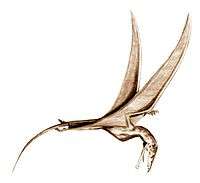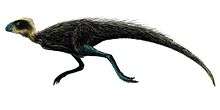Dilophosauridae
| Dilophosaurids Temporal range: Late Triassic - Early Jurassic, 200–188 Ma | |
|---|---|
| Scientific classification | |
| Kingdom: | Animalia |
| Phylum: | Chordata |
| Class: | Reptilia |
| Clade: | Dinosauria |
| Order: | Saurischia |
| Suborder: | Theropoda |
| Clade: | Neotheropoda |
| Family: | †Dilophosauridae Madsen & Welles, 2000 |
| Genera[1] | |
Dilophosaurids were a group of early large carnivorous dinosaurs.
Description
Dilophosaurs were large bipedal predators with lengths of 4 to 7 metres and estimated adult weights of 300 to 500 kg. They are well known for their distinctive head crests, which were probably used for mating displays, or to intimidate rivals.[2]
Classification
The family Dilophosauridae was proposed by Alan Charig and Andrew Milner in 1990 to contain only the type genus, Dilophosaurus.[3] Other genera, such as Zupaysaurus and Dracovenator, have since been assigned to this family, though the group has never been given a phylogenetic definition and is not currently a clade. Some studies have suggested that there was a natural group of medium-sized crested theropods which included Dilophosaurus as well as Dracovenator, Cryolophosaurus, and Sinosaurus, though it has not been formally named Dilophosauridae.[4] While traditionally assigned to the superfamily Coelophysoidea, these analyses suggest that dilophosaurids may have been more closely related to the group Tetanurae, comprising the more advanced megalosaurs, carnosaurs and coelurosaurs.
The following cladogram outlines the relationships of Dilophosaurus and its close relatives as recovered by the 2007 analysis of Smith, Makovicky, Pol, Hammer, and Currie.[4]
| Neotheropoda |
| ||||||||||||||||||||||||||||||||||||||||||
| |
The following family tree illustrates a synthesis of the relationships of the early theropod groups compiled by Hendrickx et al. in 2015, and follows more recent research showing a more restricted Dilophosauridae.[5]
| Neotheropoda |
| |||||||||||||||||||||||||||||||||||||||||||||||||||
| |
Paleobiology
All dilophosaurids are known for large, distinctive, head crests. These crests have been thought to have had many different uses, including being used for display, to attract mates, or intimidate rivals. It has been suggested that the crests symbolized sexual dimorphism, but this interpretation of the crests is controversial. Another distinctive cranial feature is a notch between the premaxilla and maxilla, giving dilophosaurids a crocodile-like appearance. This makes some people, for example David B. Norman, suspect that their front teeth were too weak to bring down prey, and that they were scavengers. Tracks found in Utah might show that dilophosaurids could swim, implying that they fed on fish.[6]
References
- ↑ Holtz, Thomas R. Jr. (2012) Dinosaurs: The Most Complete, Up-to-Date Encyclopedia for Dinosaur Lovers of All Ages, Winter 2011 Appendix.
- ↑ Holtz, Tom. "Dilophosaurs". Palaeos. Retrieved 22 November 2013.
- ↑ Charig, A.J. and Milner, A.C. (1990). "The systematic position of Baryonyx walkeri, in the light of Gauthier's reclassification of the Theropoda." In Carpenter, K. and Currie, P.J. (eds.), Dinosaur Systematics: Perspectives and Approaches, Cambridge University Press: 127-140.
- 1 2 Smith, N.D., Makovicky, P.J., Pol, D., Hammer, W.R., and Currie, P.J. (2007). "The dinosaurs of the Early Jurassic Hanson Formation of the Central Transantarctic Mountains: Phylogenetic review and synthesis." In Cooper, A.K. and Raymond, C.R. et al. (eds.), Antarctica: A Keystone in a Changing World––Online Proceedings of the 10th ISAES, USGS Open-File Report 2007-1047, Short Research Paper 003, 5 p.; doi:10.3133/of2007-1047.srp003.
- ↑ Hendrickx, C., Hartman, S.A., & Mateus, O. (2015). An Overview of Non- Avian Theropod Discoveries and Classification. PalArch’s Journal of Vertebrate Palaeontology, 12(1): 1-73.
- ↑ Xing, L.D. (2012). "Sinosaurus from Southwestern China". Department of Biological Sciences, University of Alberta. Edmonton: 1–286.



